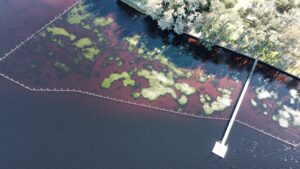As we wrap up year two of our 5-year SAVe Our River’s Grasses Expedition, we want to thank all of our partners who continue to share their dedication, docks, boats and knowledge of the river we all share and love.
What started off as a strong showing for SAV in 2024 was quickly undermined by high, dark water following Hurricane Milton and the breach of protective SAV enclosures.
 During our May 2024 Field Visit, SAV beds were more extensive with measurable improvement in canopy heights and greater diversity.
During our May 2024 Field Visit, SAV beds were more extensive with measurable improvement in canopy heights and greater diversity.
When we returned in August 2024, there continued to be measurable improvements, but also reasons to be concerned. Water temperatures were elevated compared to August 2023. Eleven of the 14 sites exceeded the healthy parameter for Chlorophyll-a and 50% of our sites had harmful algal blooms present making them inaccessible due to our safety protocols.
There was an alarming loss of SAV along the expedition route in October 2024. Hurricane Milton flooded the river with excess tannins from nearby swamps, transforming our blackwater river from an iced tea clarity to a coffee-like opacity. These conditions blocked essential sunlight from reaching the river’s struggling eelgrass.

Dancy Point enclosure in early 2024
To make matters worse, the protective enclosure located at Dancy Point in East Palatka was compromised in early September. The eel grass that once reached historic conditions succumbed to grazer pressure in approximately three weeks’ time and was reduced to stubble by our October field survey.
While there is not a silver bullet solution that will SAVe our river’s grass, we must take a holistic, watershed wide approach to tackle SAV stress and restore ideal conditions for our river’s grass. We must:
- Increase Light Availability
- Stabilize the St. Johns River Estuary’s Critical Salt/Freshwater Balance
- Improve Water Quality
- Increase the Resilience of the St. Johns River
- Expand SAV Biomass to Reduce Grazing Pressure
 Strategies Include:
Strategies Include:
- Protect the St. Johns River Headwaters (Upper Basin)
- Ban the land disposal of sewage sludge and demand regulatory oversight, enforcement and reasonable assurances as required by law of all projects throughout the St. Johns River watershed.
- Reunite the Rivers
- Restoring the natural connection between Silver Springs, Ocklawaha and the St. Johns will provide one of the most significant boosts to the river’s natural ability to support healthy SAV. Benefits include:
- Add an average of 150 MGD of clearer, cooler freshwater that will help SAV growth and offset saltwater intrusion
- Provide an eelgrass/SAV seed source
- Expand food sources for hungry grazers
- Restoring the natural connection between Silver Springs, Ocklawaha and the St. Johns will provide one of the most significant boosts to the river’s natural ability to support healthy SAV. Benefits include:
- Live within our water means, prioritize water conservation/springs protection
- Adopt a Water Reservation for the St. Johns River Estuary
- A water reservation is a legal mechanism, authorized by Florida Statutes, to set aside water for the protection of fish and wildlife or public health and safety but it is only used currently in South Florida. The St. Johns River Estuary deserves to be equally protected.
- Reduce Nutrient Pollution Watershed-wide
- Make our River More Resilient
- Prioritize land conservation, sustainable development and green infrastructure.
- Conduct More Research
- Are higher, darker water levels the new normal? If so, what do we do to offset the harm? Slow down the rise?
- Are pesticides, herbicides and aggressive invasive plant management undermining SAV presence?
- How do we make our river more resilient to extreme climate events?
- How can we eradicate invasive tilapia?
- Are there other factors undermining SAV health that are not on our radar?
 SJRK Enclosure Initiative
SJRK Enclosure Initiative
We are currently undergoing the permitting process to install small-scale exclusion fences in the St. Johns River along our expedition route.
This effort in partnership with Coastal Conservation Association (CCA), Mighty River Recovery (MRR) and riverfront homeowners will remove grazing pressure from 10 sites along the expedition route, allowing SAV to grow freely and provide more data to identify other long-term solutions.
In 2025, we will continue this effort thanks to all of you!
2024 Expedition Report
For more details about each field visit, data collected, background information, and more, read our 2024 Expedition Report.
Support Our River’s Grasses
Each of our SAVe Our River’s Grasses field visits costs up to $15,000 for staffing, water quality testing, lodging, fuel, equipment, and supplies.
Please consider a gift to help support our SAV research and advocacy efforts so we can continue this vital work to protect some of the most threatened habitat in our watershed. Make a gift online here.
